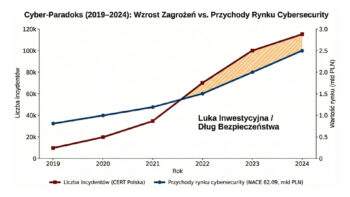In the world of technology, it is often said that the big companies set the trends, but it is the smaller ones that carry them out. The problem is that when the global economy starts to tremble, it is the smaller ones – software houses, SMEs, startups and integrators – that lose ground first. The latest data from S&P’s Global Market Intelligence report shows this starkly: political and economic uncertainty caused by tariff threats and trade tensions has caused companies to cut back on IT spending, with the smallest players bearing the brunt of these decisions.
Big ones play cautiously, small ones lose liquidity
At the start of 2025, IT budgets looked promising. Gartner was forecasting a 10 per cent increase in global technology spending and companies were launching new projects. In the second quarter, however, optimism dimmed. US trade policy, rising international tensions and inflation forced many corporations to take a more cautious approach. According to S&P analysts, larger companies are cutting back on investments faster, but have the financial buffer and ability to survive shutdowns. For smaller companies, any such stoppage means a real liquidity risk.
This phenomenon is well illustrated by the comparison cited by analysts: when large companies ‘catch a cold’, small companies get the flu. An example? When a large corporation suspends a pilot project or delays the rollout of a new application, for the software house this means missing payments and having to reduce the team. Such cascading effects are increasingly common.
Projects on hold, development frozen
In the S&P report, more than half of respondents indicated that, in the face of external economic turmoil, their companies have adopted a wait-and-see strategy. First, ‘experimental’ budgets – intended for prototypes, AI testing, R&D projects – are disappearing. Later, implementations whose business value has not yet been fully proven are cut back.
Small and medium-sized technology companies that often make their living from such initiatives – especially those in the innovation, automation or AI sectors – are feeling this particularly acutely. Many of them base their business model on responding flexibly to the needs of corporate customers, meanwhile these customers hold their breath and freeze their decisions.
Outsourcing under censorship
Another trend that is hitting smaller companies painfully is the reduction in spending on IT outsourcing, consulting and managed services. With business uncertainty, companies are reverting to an ‘in-house’ model – they want more control over strategic IT processes. Outsourcing budgets are shrinking and so are the markets for MSPs and managed services partners.
For many small and medium-sized players, this means not only a loss of customers, but also the need to reorganise the operating model. Not only does lower demand become a problem, but also price pressure and loss of scale.
Worse financial resilience
Small companies rarely have access to lines of credit or strategic investors. They operate on a short reserve, often settling on a project or subscription basis with clients. When one of their counterparties withholds payment or abandons a project, the effects are immediate. In Poland, an increasing number of SME companies are suspending operations or declaring bankruptcy – and these figures increasingly apply to the IT industry as well.
It is not just about dramatic cases. The very necessity of maintaining liquidity means abandoning development plans, stopping recruitment, reducing spending on marketing or certification. This in turn reduces competitiveness in subsequent tenders and the spiral deepens.
What are companies still investing in?
Despite the cuts, certain categories of IT spending remain untouched. Cloud, security and AI infrastructure continue to attract budgets because they are seen as crucial for business continuity. Only that these budgets are mainly accessed by larger players – global cloud providers, certified partners or companies with experience in large security projects.
For smaller companies, this means increasing pressure to re-brand quickly and become competent in these areas. The problem, however, is a lack of time, resources and competence – and the market does not forgive delays.
Which strategies make sense?
Not all companies are helpless in the face of the crisis. Some are already implementing adaptation strategies:
- Diversifying clients – looking for orders in the public sector, which is sometimes more resilient to market fluctuations, or expanding into other markets.
- Partnerships – smaller companies join forces to deliver larger projects and bid together.
- Shifting competences – increasing competences in areas that are difficult to cut from budgets, such as compliance, cloud maintenance or security monitoring.
At the same time, there is no shortage of companies making bold decisions: limiting business to key customers, freezing sales of new services to focus on maintaining service quality.
The struggle for survival
Economic and political uncertainty is like a stress test for the technology sector. Large players have the time and resources to react strategically. Smaller ones are operating on the brink of reactivity, trying to survive before the situation stabilises. What used to be an advantage – agility, niche specialisation, low costs – is not enough today.
For many of these companies, the coming months will be a battle not for innovation, but for survival. Who wins it will be determined not so much by technology, but by the ability to adapt and respond quickly to a changing environment. And whether they can find a place in the new balance of power, in which only part of IT budgets remain untouchable.












